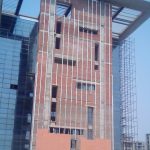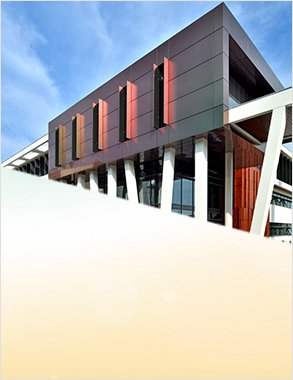The facade of a building serves as its face, creating the first impression for visitors and passersby. In recent years, there has been a significant shift in architecture towards innovative and sustainable solutions for building exteriors. One such solution that has gained popularity is cladding materials. Cladding offers both aesthetic appeal and functional benefits, transforming the look and performance of structures. In this blog, we will explore the world of cladding materials and their role as an innovative facade solution for building exteriors.
Post your Requirement
Understanding Cladding
Cladding is the application of an external layer to a building’s structure, providing an additional protective skin. It can be made from a diverse range of materials, including but not limited to metal, wood, stone, glass, concrete, and composite materials. Cladding serves several crucial purposes, such as weather resistance, thermal insulation, noise reduction, and enhancing the building’s overall appearance.
Innovative Cladding Materials
Fiber Cement Cladding:
This material combines the durability of cement with the flexibility of wood fibers. Fiber cement cladding is resistant to fire, water, and pests, making it an excellent choice for both residential and commercial buildings. It can mimic the appearance of natural wood while requiring minimal maintenance, making it an eco-friendly option.
Green Facades:
Green facades involve the use of climbing plants and vines, creating a living layer over the building’s exterior. Apart from providing an aesthetically pleasing appearance, green facades also offer thermal regulation, air purification, and biodiversity benefits. They contribute to a more sustainable urban environment by reducing the heat island effect.
Terracotta Cladding:
Terracotta cladding brings a touch of tradition and craftsmanship to contemporary architecture. Its earthy tones and textures add warmth to the facade. Additionally, terracotta panels have excellent thermal properties, contributing to energy efficiency.
Composite Panels:
Composite cladding materials combine two or more materials to create a single, high-performance product. For example, wooxd-plastic composites (WPCs) consist of wood fibers and recycled plastic, offering the appearance of wood with increased durability and reduced maintenance needs.
Photovoltaic Cladding:
Integrating solar panels into the building’s facade allows it to generate clean energy from sunlight. Photovoltaic cladding not only provides an innovative and futuristic appearance but also contributes to the building’s sustainability by reducing its reliance on conventional energy sources.
Technical Benefits of Well Managed Cladding
- External cladding scores in a number of ways, including its protection against weather elements, relatively lower maintenance, ability to reduce water absorption into the building, resistance to pollution, and increasing the mechanical strength of a structure, says Shubham Jain of JP Infra. The cladding further provides thermal insulation, reduces the temperature variation inside the building, and improves acoustics.
- According to architect Kembhavi, a facade can be properly managed if it can optimize various functions, such as optimal daylight, reduction of thermal gain, acoustic insulation, and energy generation through seamless integration of photovoltaic and fire resistance. Interior comfort conditions evolve through optimized thermal and visual conditions. It is paramount that adequate daylight and views are brought into an interior space, as they help balance the body’s biorhythms.
- Bimal Patel of HCP also opines that a well-managed facade reduces the direct solar exposure of the usable spaces. This results in reduction of the cooling load. A facade system that could be operated by the end-user also allows for taking in diffused light, reducing glare, and reducing exposure to dust for the window system behind it.
- A well-managed and designed facade ensures that it becomes performative and progresses to an active element of the design, creating comfortable conditions within the space. The detailing and system used should be carefully done based on the use of the building, comments Amit Gupta of Studio Symbiosis. Little details make the difference in the quality of space being created and in the quality of execution to allow the façade to alter gracefully, points out Gupta.
- Good thermal and vapor barrier performance increases building life and, in some cases, even increases the quality of the air surrounding the facade. According to Arjun Malik of Kamal Malik Architecture, the whole point of a façade is to create a barrier/interface between interior and exterior environments. The potential to save energy can be maximized by good design and good technology.
- When design teams select an effective cladding solution for their facility, their building realizes a number of high-performance benefits, including easier maintenance, effective waterproofing, constructability, and durability, opines Carl Hampson of Cannon Design. He points out that building owners should focus on these four benefits when they are having discussions with their design partners.
- In accordance with Hampson, Sumandeep Singh, HKS also points out that the technical aspects of a well-managed cladding include complete protection from weather elements and should be leak proof. If well detailed, then the cladding panels can last longer. Cladding materials also provide insulation and, hence, help reduce air conditioning loads.
- Cladding is an integral part of a wall assembly and is responsible for the building’s overall thermal performance. Cladding protects a building from moisture and wind. It should be weather-resistant, leak-proof, moisture-proof, fire-resistant, long-lasting, and help reduce Air conditioning loads. At the same time, the cladding should add aesthetic value to the whole structure, giving it a niche look. It can be concluded that the technical benefits of well-mannered cladding include lower maintenance, creating comfortable conditions within the space with better thermal and acoustic insulation. The biggest savings are in terms of construction time being reduced along with a reduction in labor, as most well-managed cladding systems come in meticulously engineered kits of parts’, contributing to an easy-to-work modular system.
Choosing Cladding Materials
- Each project is different; hence, the material chosen should be based on the overall design concept. It also comes down to the properties of the material in terms of execution and weight. All cladding materials have their own unique properties and age differently. Execution and maintenance should be criteria, but if the execution is done to a high standard, there should be no problem with either of the two.
- The cladding materials have to suit the project type, cost, and functionality. “While choosing the material, one should also consider that it should be robust and serve the purpose of shielding the interiors from harsh weather,” says Ar. Patel.
- Facade designs are selected based on a number of criteria like workability, jointing systems, panel sizes, prevailing climate and rain conditions, permanent weatherproof barrier vs. rain/thermal screen, and their relationship to the surrounding area, says Ar. Malik.
- The selection of cladding material is essentially based on the following parameters: building type, environment, budget, and maintenance, says Kembahavi. Ar. Reza Kabul too opines that the selection of the façade and cladding material depends on the locale, the characteristics of the material, and the requirements of the structure. Appropriately considering these factors adds to the sustainability of the project. The budget is also a deciding factor in the choice of cladding material.
- When choosing cladding materials, we have to consider their aesthetic appropriateness and appeal. One needs to look at materials that can be quickly installed. Ease of workability and maintenance are also the biggest determining factors when choosing the cladding material. But we strive each time to select cladding materials that are most natural and contribute to the overall performance of the facade. Execution and maintenance should be a criterion, but if the execution is done to a high standard, there should be no problem with either of the two.
Benefits of Cladding Materials
Enhanced Aesthetics:
Cladding materials offer diverse textures, colors, and finishes, allowing architects and designers to create visually stunning exteriors that reflect the building’s purpose and surrounding environment.
Improved Weather Resistance:
Cladding acts as a protective shield, safeguarding the building against harsh weather conditions such as rain, wind, and UV radiation. This increases the structure’s lifespan and reduces maintenance costs.
Energy Efficiency:
Certain cladding materials, like insulated metal panels or green facades, enhance the building’s thermal performance, reducing the need for excessive heating or cooling. Consequently, this promotes energy efficiency and lowers utility expenses.
Sustainable Solution:
With the increasing emphasis on sustainable construction, many cladding materials are eco-friendly, recyclable, or made from renewable resources, reducing the overall environmental impact of buildings.
Conclusion
Cladding materials have emerged as a game-changer in modern architecture, offering innovative and sustainable facade solutions for building exteriors. From improving aesthetics to enhancing energy efficiency and promoting sustainability, cladding materials present a plethora of benefits. As technology continues to advance, we can expect even more exciting developments in the realm of cladding, revolutionizing the way we perceive and construct buildings in the future. So, the next time you come across an awe-inspiring building, take a moment to appreciate the role of cladding in elevating its beauty and functionality.




















Post A Comment